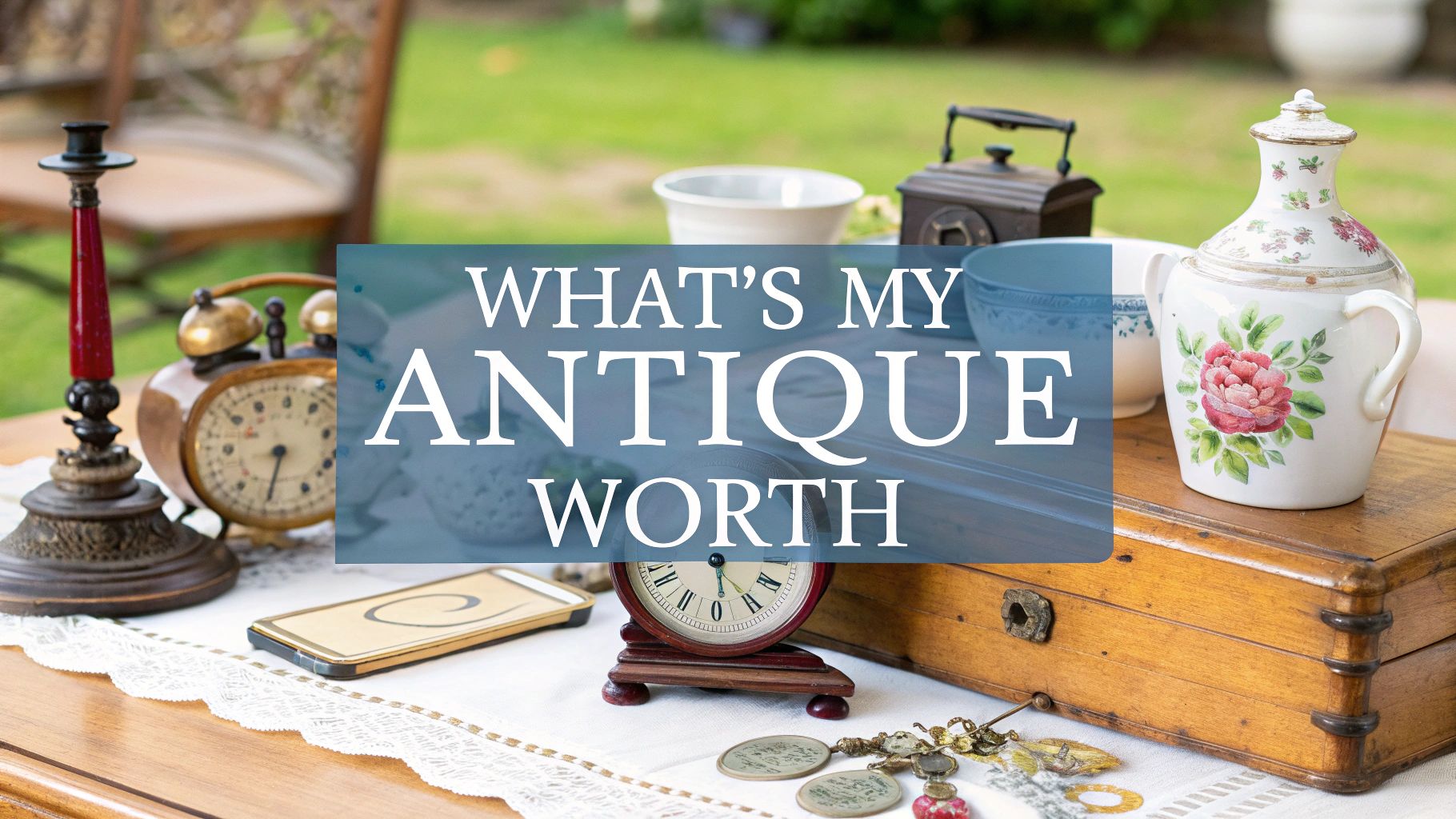So, you want to figure out what your antique is worth? It all comes down to understanding the four things that really drive its value: Age, Condition, Rarity, and Provenance. An item's price tag is rarely just about how old it is; it’s the unique blend of these factors that collectors and appraisers look at to land on a final number.
Your Quick Guide to Antique Valuation
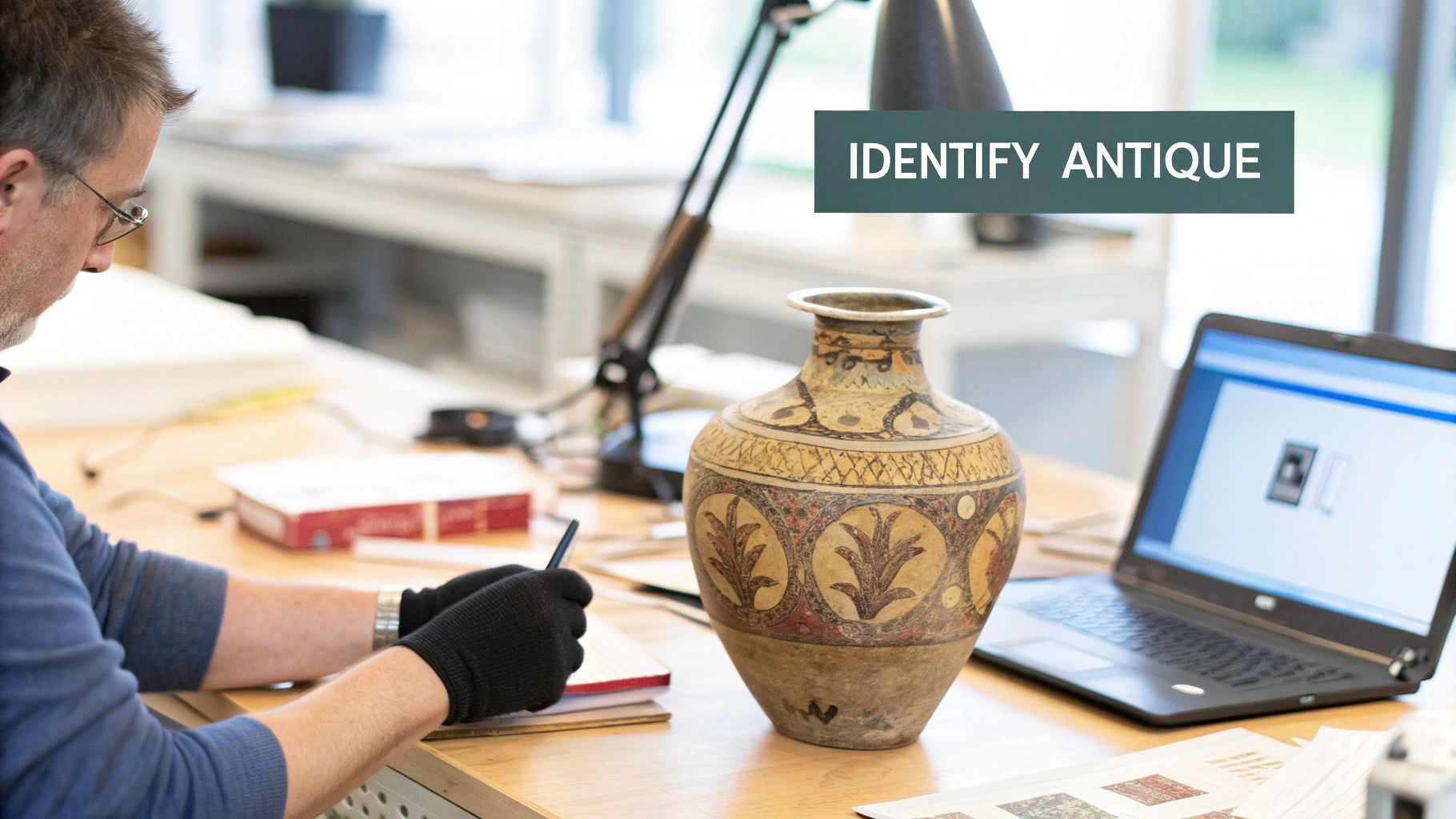
Ever stumble upon a dusty old box in the attic and get that little spark of curiosity—"I wonder what this is worth?" You're definitely not alone. Kicking off that journey into an object's past is exciting, but let's be honest, figuring out the value can feel like a maze of confusing terms and conflicting advice.
This guide is here to cut through the noise. We'll break it all down by focusing on the core principles that truly matter. Think of it as learning the "language" of antiques, which is built on four key pillars: Age, Condition, Rarity, and Provenance (the item's history). Getting a handle on these is the first real step toward seeing your piece the way a seasoned appraiser would.
An antique's value is really a story told by four key elements. Age sets the scene, Condition shows how well it has survived, Rarity makes it special, and Provenance adds the historical plot twists that can make it priceless.
Choosing the Right Valuation Method
Before you dive headfirst into your investigation, it helps to know which path to take. Different situations call for different approaches. A quick online search might be perfect for that garage sale find you're curious about, but you'll need a formal, certified appraisal to properly insure a precious family heirloom. Each method has its place.
The table below gives you a quick, at-a-glance comparison to help you choose the best route for your item and your goals.
Comparing Antique Valuation Methods
A quick look at common methods for determining an antique's value, outlining their pros, cons, and best uses.
| Valuation Method | Best For | Pros | Cons |
|---|---|---|---|
| DIY Online Research | Getting a quick, informal estimate for common items or just satisfying your curiosity. | Free, fast, and accessible. It's a great starting point for getting a ballpark figure. | Information can be unreliable or inaccurate. It takes time to find good "comps" to compare against. |
| AI-Powered Apps (like Curio) | Instant identification and value estimates for a wide range of items, right from your phone. | Incredibly fast and easy. It often provides historical context and helps organize your collection. | Estimates are based on market data and might not capture every unique detail of your specific item. |
| Professional Appraisal | Insurance coverage, estate planning, or selling high-value pieces where accuracy is essential. | You get a detailed, legally recognized report from a certified expert. It's the gold standard. | Can be quite expensive and takes more time to arrange compared to other, more casual methods. |
Ultimately, picking the right method comes down to what you need. Are you just curious, or do you need a number you can take to the bank (or the insurance company)? Answering that question will point you in the right direction.
The Four Pillars of an Antique's Value
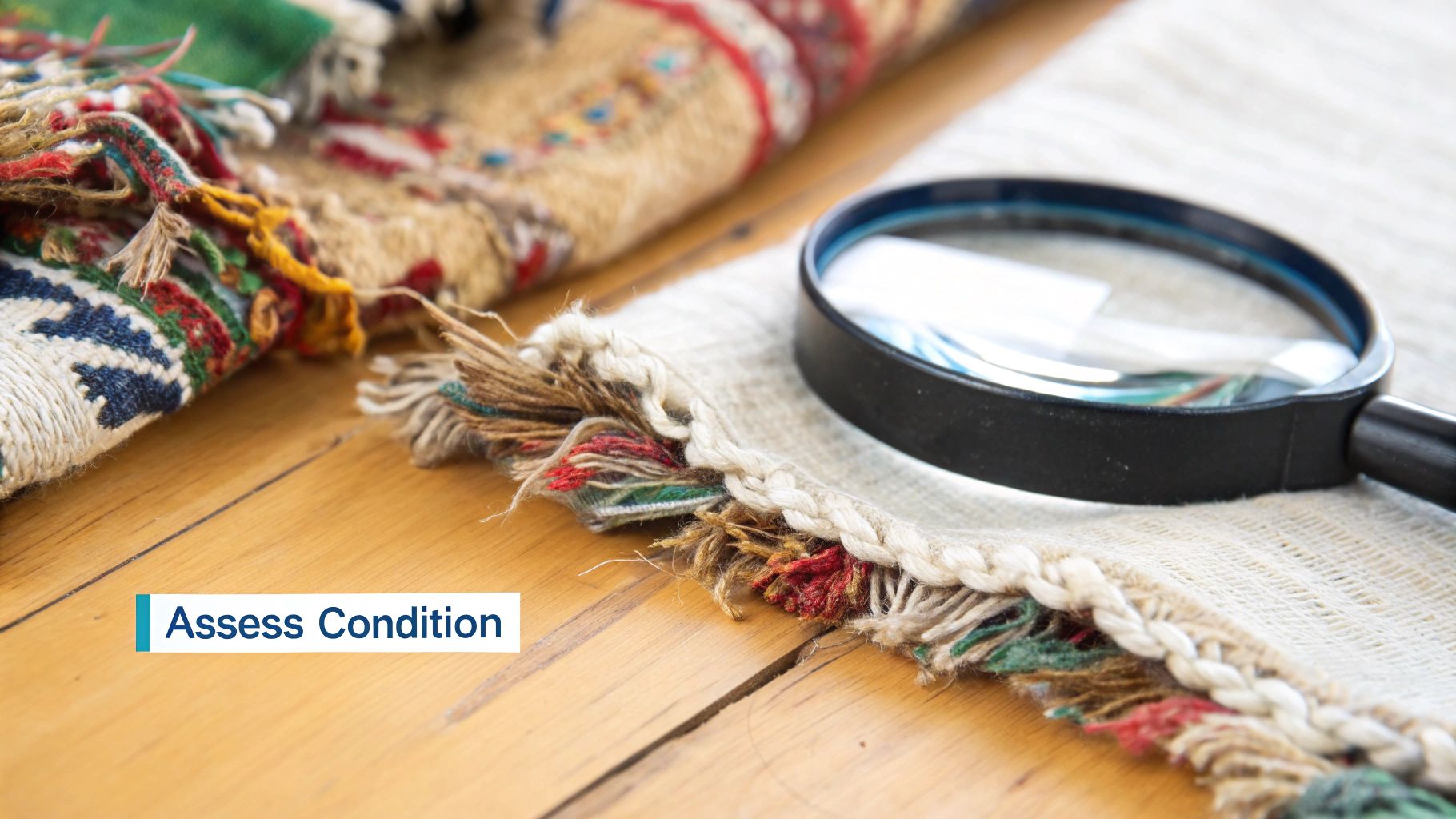
If you've ever held an old family heirloom and wondered, "What is this actually worth?", you're asking the same question every appraiser starts with. The answer isn't just a number pulled from thin air. Instead, an antique's value rests on four key pillars: Age, Condition, Rarity, and Provenance.
Think of these four pillars like the legs of a sturdy old table. If one leg is wobbly or missing, the whole thing loses its stability—and its value. But when all four are strong, you have a solid, desirable piece that collectors will pay a premium for. Let's break down what each one really means.
Age and Condition
It’s true that for something to be considered an antique, it generally has to be at least 100 years old. But age itself isn't the whole story. Age simply gets your item in the door, giving it a place in history and connecting it to a specific style, maker, or period.
Condition, on the other hand, is the real game-changer. Picture two nearly identical rocking chairs made in 1890. One has been lovingly cared for, with its original finish intact and only minor signs of use. The other has a cracked rocker, faded upholstery, and a wobbly frame. It’s obvious which one is more valuable. A little wear can add character, but significant damage, repairs, or missing parts can tank an item's worth.
An antique's value is a conversation between its past and its present. Age initiates the dialogue, but its current condition often has the final say in determining its worth to a collector.
For a more detailed look at how these two factors work together, our guide on how to find the value of antiques is a great resource.
Rarity and Provenance
Next up is rarity, which boils down to simple supply and demand. If thousands of a particular teapot were made, finding one is easy, which naturally keeps the price modest. But what if only a handful were ever produced, and even fewer have survived the test of time? Suddenly, that teapot becomes a treasure. Uniqueness is a massive driver of value.
Then there’s provenance, which is my personal favorite. This is the item's documented history—its life story. It could be an old sales receipt, a letter from the original owner, or even a photograph of it sitting in a historic home. Think of it like a baseball: it's just a regular ball until it's autographed by a famous player. That signature—that proof of connection—is what makes it special and dramatically increases its value. A solid provenance linking an item to a famous person, place, or event can make its price skyrocket.
This is where market trends also play a huge role. Right now, the resale market is exploding, growing about 21 times faster than the broader retail market. Younger buyers are drawn to the unique styles and sustainability of older pieces, sparking a renewed interest in everything from folk art to Mid-Century Modern furniture. This demand directly impacts an item’s perceived rarity and, ultimately, its price on the open market.
How to Research Your Antique's Value Yourself
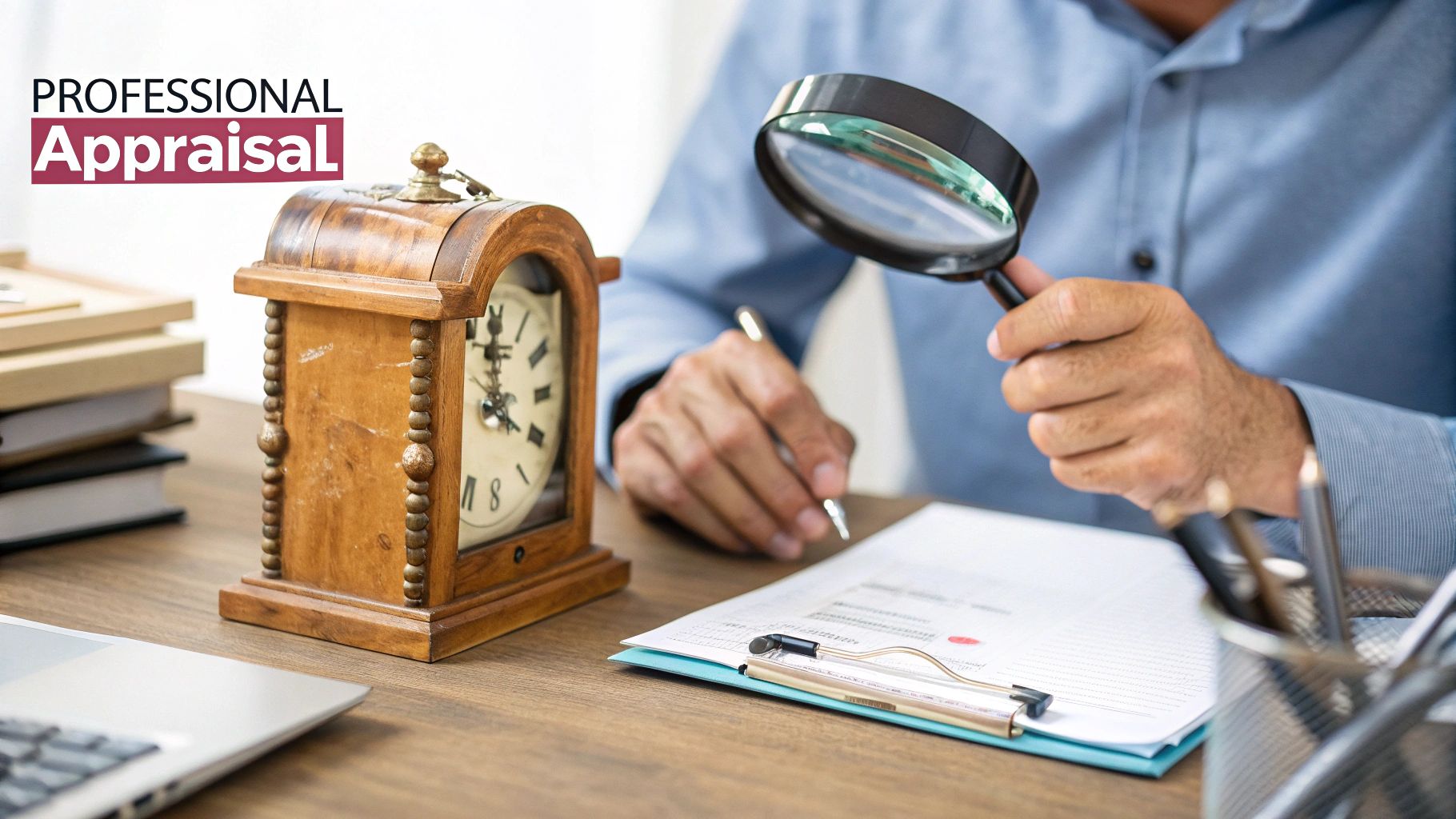
Before you pick up the phone to call an expert, you can do a surprising amount of detective work on your own. Doing your own research is a great first step. It helps you establish a baseline value and decide whether it’s even worth getting a formal appraisal.
This hands-on investigation starts by looking for clues hidden on the item itself. Your first mission is to find any identifying marks that can unlock its story.
Finding an Item's Unique Fingerprint
Think of these little marks as your antique's unique fingerprint. They can be tiny, but they often tell you everything you need to know. When you're examining your piece, look very closely for:
- Maker's Marks: These are the symbols, stamps, or logos the manufacturer used. You'll often find them on the bottom of ceramics, tucked away inside a furniture drawer, or on the back of a painting.
- Signatures: Artists and artisans frequently signed their work. A clear signature can instantly link your piece to a well-known—and potentially valuable—creator.
- Patent Numbers or Dates: These are fantastic clues. They can help you nail down the exact time your item was made, which is crucial for figuring out its age.
- Country of Origin: If you see a country name stamped on the bottom, it was likely made after 1891. If it says "Made in…," it was probably produced after 1914 due to changes in import laws.
Once you’ve gathered these clues, you’re ready to hit the internet. This is where you’ll look for "comparables," or ‘comps’—items just like yours that have sold recently. It's the same fundamental approach a real estate agent uses to price a house, and it works remarkably well for antiques, too.
The most reliable value isn’t what someone is asking for an item, but what someone has actually paid for it. Your goal is to find sold prices, not just current listings.
Using Online Databases for Valuation
To find those all-important comparables, you need to know where to look. Online databases and auction archives are going to be your best friends. These resources compile millions of sales records from auction houses and online marketplaces all over the world.
A real powerhouse for this kind of research is WorthPoint, a massive database that pulls in sales data from hundreds of different sources. The image above shows its search page, where you can type in keywords from your item’s marks or description to pull up matching sales records. Digging through these results shows you what similar pieces have actually sold for, giving you a realistic, evidence-based idea of your antique's market value.
This initial legwork gives you more than just a number; it gives you knowledge. You'll walk away with a ballpark estimate and a collection of details that will be invaluable if you do decide to seek a professional opinion later on.
How Market Trends Influence Antique Prices
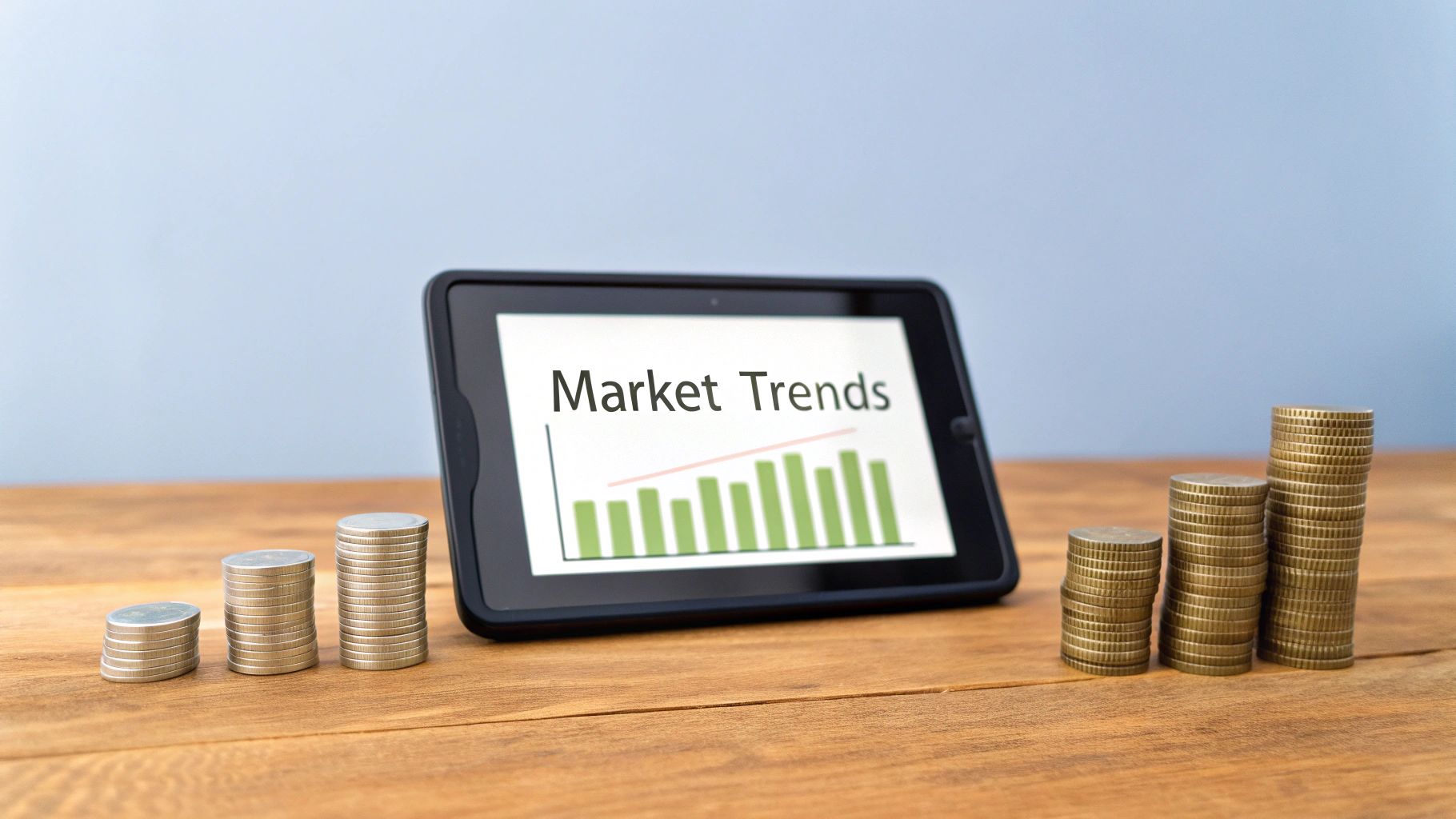
An antique’s value isn't a fixed number carved in stone. It’s much more like a stock price, constantly rising and falling with the tide of public demand. To truly answer the question, "what is my antique worth?" you have to look beyond the object in your hands and understand the bigger picture.
Think of it like the fashion world. One minute, minimalism is in, and the next, everyone wants bold, decorative patterns. The same thing happens with antiques. Shifting interior design tastes are a huge driver; a craze for clean, functional spaces can make Mid-Century Modern furniture suddenly fly off the shelves. A few years later, a renewed love for ornate details might send Art Deco prices soaring.
These cultural tides mean an item's value is always in motion, influenced by everything from popular TV shows to global economic shifts. Getting a feel for this context is absolutely essential.
Riding the Wave of Popular Demand
The global antique market is a living, breathing thing. In 2024 alone, it generated about USD 58.4 billion in revenue and is projected to keep growing. A big reason for this is how online platforms have connected buyers and sellers from every corner of the globe.
Interestingly, it's not all about million-dollar masterpieces. The mid-price range—items valued between $50 and $500—makes up a whopping 49% of the market. This is fueled by everyday collectors looking for unique yet affordable pieces, from vintage toys to limited-edition prints.
This global connection means demand can spike from anywhere. For example, a growing community of new collectors in Asia might suddenly develop a passion for a specific type of European porcelain. This can drive up prices for items that were once only popular in their home countries.
The value of your antique is not just what it is, but what people want it to be. Market trends are the ultimate reflection of collective desire, turning overlooked objects into coveted treasures.
From Estate Sales to Global Trends
You can see this principle of supply and demand in action everywhere, especially at places like estate sales. Knowing which categories are currently "hot" can make a massive difference in how you price things. If rustic farmhouse decor is all over design blogs, that simple, well-made wooden table might fetch a much higher price than it would have a few years ago.
Understanding these larger market dynamics gives you vital context. It explains why the estimated value of your antique might be completely different today than it was a decade ago. It also lets you be more strategic when you decide to sell. If you know your item falls into a category that’s in high demand, you can position it to catch the eye of the right buyers at the right time. Our guide on how to price estate sale items offers more practical tips on this very topic.
When to Hire a Professional Appraiser
Doing your own research or using a tool like Curio is a fantastic first step. Think of it as your initial fact-finding mission to get a ballpark idea of what your antique might be worth. But some situations call for bringing in a specialist.
It's a lot like personal finance. You might manage your own budget just fine, but you'd hire a certified accountant for a tax audit or complex investment strategy. A professional appraiser is that specialist for your antiques—they provide an official, legally recognized valuation when the stakes are high.
Key Moments for a Formal Appraisal
So, when should you make that call? Certain scenarios demand the kind of formal documentation that only a certified pro can deliver. It’s the smart move when you need a number that will hold up under official scrutiny.
Here are the most common times you'll want to hire a professional:
- Insurance Coverage: To properly insure a valuable piece, you’ll need an official appraisal report. This document establishes the replacement value—what it would cost to buy a similar item today. This figure is often higher than what you could sell it for, ensuring you’re fully covered if the worst happens.
- Estate Planning and Settlement: When dividing assets for an estate, a formal appraisal provides a clear, unbiased value for everyone involved. It’s the best way to prevent family disputes and ensure a fair, equitable distribution.
- Charitable Donations: If you’re donating an antique and hoping to claim a significant tax deduction, the IRS will require a "qualified appraisal" performed by a certified expert. There's no getting around this one.
- Selling High-Value Items: For anything worth thousands of dollars, an appraisal gives you serious credibility. It empowers you to set a firm, justifiable asking price and gives potential buyers the confidence they need to commit.
Finding a Qualified Expert
Be picky. Not all appraisers are the same, and you need someone who truly understands your specific type of antique.
A great place to start is by looking for members of respected organizations like the American Society of Appraisers (ASA) or the International Society of Appraisers (ISA). Always check their credentials, confirm their specialization, and get their fee structure in writing before you agree to anything.
The antiques market is global, and good appraisers know this. They keep a close eye on international trends, like how growing participation from emerging markets has boosted antique values by an estimated 15-25% in recent years. Today's experts are also using technology to get more accurate results, from AI-powered data analysis to blockchain for authentication. You can discover more about how technology is influencing the luxury antiques market on MozerIsFineAntiques.com.
The purpose of your appraisal dictates the type of value the appraiser determines. Fair Market Value is for selling, Replacement Value is for insurance, and Liquidation Value is for a quick sale—and each can be a very different number.
Ultimately, investing in a professional appraisal is about peace of mind and financial protection. It turns your educated guess into a documented, defensible figure. To get a complete picture of the valuation process, be sure to read our comprehensive antique valuation guide.
Common Questions About Valuing Antiques
If you've ever found yourself staring at an old piece of furniture and wondering, "What is this actually worth?", you're not alone. A few key questions come up over and over again for anyone dipping their toes into the world of antiques. Getting these sorted out can save you from a lot of confusion—and even some expensive mistakes.
Let’s walk through the answers to the questions I hear most often.
Is It an Antique or Just Vintage?
This is probably the most common mix-up, but the distinction is pretty straightforward. The two terms aren't interchangeable; they're specific labels based on age.
- Antique: To earn this title, an item has to be at least 100 years old. That's the benchmark used by professional appraisers, dealers, and serious collectors across the board.
- Vintage: This term is a bit more flexible. Generally, it applies to items that are between 30 and 99 years old. Think of cool finds from the 1950s, 60s, or even 70s.
Knowing the difference is your first step. An 80-year-old Art Deco lamp is certainly a valuable vintage piece, but it's not technically an antique. Not yet, anyway.
Does Refinishing an Antique Hurt Its Value?
In almost every case, yes, it absolutely does. Most collectors aren't just buying an object; they're buying its history. That original finish and the subtle signs of age—what experts call patina—are a huge part of its story and its value.
Think of it like this: refinishing a historic piece of furniture is like taking a first-edition book and slapping a brand-new, glossy cover on it. You might think it looks "cleaner," but you've just erased the very soul of what made it authentic and rare. Doing so can tank its value by as much as 90%.
There are, of course, rare exceptions. Maybe the original finish is completely gone or damaged beyond recognition. Even then, any restoration should be left to a master conservator. The golden rule is simple: don’t touch it until you've had it professionally assessed.
Can I Get a Free Antique Appraisal?
You’ll see plenty of offers for "free" appraisals online, but it pays to be skeptical. More often than not, these are just ways for dealers or auction houses to get leads. They might have a vested interest in buying your item for a low price, so the number they give you may not be entirely objective.
That said, some reputable auction houses do hold appraisal fairs or "roadshow" style events where you can get a free verbal opinion from a real expert. These are fantastic for satisfying your initial curiosity, but they aren't the same as a formal, written appraisal you'd need for insurance or estate planning.
How Much Does a Professional Appraisal Cost?
When you need a certified, documented value for serious purposes, it's time to invest in a professional. The cost really depends on the appraiser’s reputation, your location, and how complex the item is to evaluate.
Most certified appraisers charge by the hour, with rates often falling between $150 and $400 per hour. Some might offer a flat fee for a single item. A major red flag? Never, ever hire an appraiser who asks for a percentage of the item's value. That's a huge conflict of interest and a violation of professional ethics.
Ready to get a fast, reliable idea of what your items are worth without the high cost of a formal appraisal? The Curio app puts an antique expert in your pocket. Just snap a photo to get an estimated value, historical context, and more in seconds. Download Curio today and start uncovering the stories behind your treasures.
